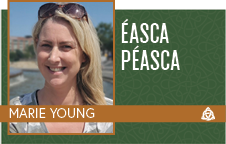

Éasca Péasca (Easy Peasy):
Student Stories: What Is the Irish Language to Me?
By Patrick Gormley
If you happen to have a time machine and travel to the Pontic-Caspian Steppe in the late Neolithic, you might hear this word being thrown around. It’s a word historical linguists have reconstructed from the ancient Proto-Indo-European language, likely spoken north of the Black Sea1 around the year 4000 BC4. As its speakers migrated and settled throughout Europe, the Middle East, and southern Asia, this one language gradually developed into the more than 400 modern Indo-European languages2, including but hardly limited to English, French, Ukrainian, Hindi, German, Pashto, Farsi, Greek, Marathi…

This subject is a passion of mine. I have been fascinated by languages since at least middle school. I took French all throughout high school; I taught myself Polish in 9th grade in preparation for a trip I was taking with my church to World Youth Day in Kraków, Poland; I dabbled in various languages throughout high school (my favorite still being Hungarian), and began teaching myself Proto-Indo-European in 11th grade.
Over the years, this has grown into an interest of Proto-Indo-European’s daughter languages: Indo-European languages that I have taught myself some amount of include Sanskrit, Proto-Balto-Slavic, Proto Germanic, Proto-Slavic, Proto-West-Germanic, Old Church Slavonic, Polish, Dutch, and Proto-Celtic, in addition to the other languages I have delved into through independent and academic study.
As a few examples, I have minored in French and Irish in my undergraduate studies, and I learned some Spanish before going to Costa Rica on a service trip over spring break in 2020. I’m currently also learning Swahili with one of my friends and bits of Luganda in my spare time, and I have plans to take up learning Old Norse and Ukrainian within the next few months.
Tir gan teanga, tir gan anam
There is an Irish saying: “tir gan teanga, tir gan anam”; that is, a country without a language is a country without a soul.
Similarly, Charlemagne is credited with having said that “to have another language is to have another soul.” Learning another language does far more than provide the learner with a new means of communication: it introduces them to another mode of thought, another “soul” of cultural heritage through which to experience the world around them. I have found this to be true many times over in learning Irish at Pitt; whether through learning traditional Irish sayings, diving into Irish-language music, or reading literature in Irish.
Some of my reasons for becoming interested in learning the Irish language is, to start, the connection with my family’s heritage. Most of my ancestors came from Ireland, the one I know the most about is my great grandfather, Owen Gormley.He came to the United States in the early 1910’s from Granlahan, in County Roscommon. He came to the United States the most recently out of my ancestors, with most of them coming either around the same time or (for some of them) several decades or even centuries earlier. Our earliest recorded ancestors in the US arrived in the 1600s.
More distantly, our last name comes from the family name Gormghaille, meaning “blue valor.” This probably refers to the ancient Irish practice of wearing blue war paint into battle. I was always inspired by having such a direct connection to a notable people from ancient times.
My connection to Ireland does not end with my ancestry, though. In my family, we used to always listen to Irish music when I was growing up. We especially have always liked Gaelic Storm, and we’ve gone to many of their concerts, especially at the Irish festival every year. Additionally, my brother plays the bagpipes (they’re Scottish, but still…), and he has used this as a segue into a vast knowledge of traditions of Irish and Celtic music. Though I unfortunately could not make it to my parents’ wedding, some of the music at the reception was in Irish, and they had Irish songs both in English and in Irish.
Irish Dance
From when I was about 5, until I was 14, my brother and I did Irish dancing with the Shovlin Academy of Irish Dance in Dormont. We were always in the parades, especially the St. Patrick’s Day parade, but also other parades throughout the year, and we competed in feiseanna frequently.
I’ve also done Ceilidh dancing before (in informal contexts), which I enjoy a lot. Doing Irish dancing has helped me with other kinds of dancing that I’ve done at other points in my life, such as tap dancing (for theater productions in high school) or more recently, swing dancing and square dancing. My appreciation for Ireland, though, is not merely from afar: we visited Ireland when I was 7 years old, and some places that I particularly loved were the giant’s causeway, Bunratty castle, and the Blarney stone.
Now, in addition to an interest in Irish culture, I also have an interest in languages. I’ve loved learning languages ever since middle school; I took French in high school and taught myself a good deal of Polish in my free time. I’m really interested in historical linguistics, particularly ancient and reconstructed languages as well as modern languages.
For example, I’m currently studying Sanskrit in my free time. So when I came to Pitt, I knew that I wanted to study a language and the LTLC department really caught my eye. When I was planning out my classes, I realized that I could complete a minor in Irish and I decided that this was the route I wanted to take. I knew that this would be a great way to pursue my interest in languages while also learning more about my heritage – and I’ve definitely enjoyed this wonderful opportunity.
So, what is the Irish language to me? It is heritage; it preserves and encapsulates the legacy of my ancestors; it transports me to a time and a place that lives on through stories and songs. It is culture; it is a language that sings of traditions and ways of life that resounded for so many centuries; it reminds me of the songs I listened to when I was younger.
It is beauty; it recalls to me the hills and cliffs of Ireland where my ancestors lived for so many generations; its echoes dance like faeries. It is memory and legacy; it is art and poetry; it is the language of priests and warriors and poets and kings. It is a language whose legacy will never die; whose beauty cannot be taken away; whose heritage can never be forgotten. It is our language. It is my language.
Citations

Monthly newsmagazine serving people of Irish descent from Cleveland to Clearwater. We cover the movers, shakers & music makers each and every month.
Since our 2006 inception, iIrish has donated more than $376,000 to local and national charities.
GET UPDATES ON THE SERIOUS & THE SHENANIGANS!